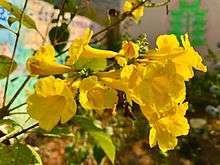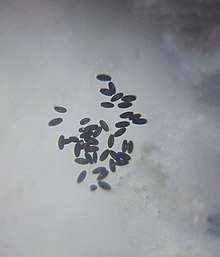Tecoma stans
Tecoma stans is a species of flowering perennial shrub in the trumpet vine family, Bignoniaceae, that is native to the Americas. Common names include yellow trumpetbush,[2] yellow bells,[2] yellow elder,[2] ginger-thomas. Tecoma stans is the official flower of the United States Virgin Islands and the floral emblem of The Bahamas.
| Tecoma stans | |
|---|---|
 | |
| Scientific classification | |
| Kingdom: | Plantae |
| Clade: | Tracheophytes |
| Clade: | Angiosperms |
| Clade: | Eudicots |
| Clade: | Asterids |
| Order: | Lamiales |
| Family: | Bignoniaceae |
| Genus: | Tecoma |
| Species: | T. stans |
| Binomial name | |
| Tecoma stans | |
| Synonyms[1] | |
| |

Description

Yellow trumpetbush is an attractive plant that is cultivated as an ornamental. It has sharply toothed, pinnate green leaves and bears large, showy, bright golden yellow trumpet-shaped flowers. It is drought-tolerant and grows well in warm climates. The flowers attract bees, butterflies, and hummingbirds.[3] The plant produces pods containing yellow seeds with papery wings. The plant is desirable fodder when it grows in fields grazed by livestock. Yellow trumpetbush is a ruderal species, readily colonizing disturbed, rocky, sandy, and cleared land and occasionally becoming an invasive weed.
References
- theplantlist.org
- "Tecoma stans". Germplasm Resources Information Network (GRIN). Agricultural Research Service (ARS), United States Department of Agriculture (USDA). Retrieved 22 December 2017.
- For example the sapphire-spangled emerald (Amazilia lactea) in Brazil (Baza Mendonça & dos Anjos 2005)
External links
| Wikimedia Commons has media related to Tecoma stans. |
| Wikispecies has information related to Tecoma stans |